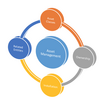-training-interview-questions-answers.jpg)
Certified Agile Leader® 1 (CAL 1™) Training empowers leaders to embrace agility and lead organizations through change with confidence. The program focuses on adaptive leadership, cultural transformation, and value-driven decision-making. Participants gain insights into fostering collaboration, psychological safety, and continuous learning across teams. With practical frameworks and real-world applications, the course helps leaders align business strategy with agile principles. CAL 1™ is ideal for managers, executives, and change leaders seeking to build resilient, innovative, and future-ready organizations.
Certified Agile Leader® 1 (CAL 1™) Training Interview Questions Answers - For Intermediate
1. How does CAL 1 training help leaders adapt to uncertainty?
CAL 1 training emphasizes adaptive leadership, teaching leaders to remain flexible and resilient in unpredictable environments. Leaders learn to use experimentation, feedback loops, and incremental progress to navigate uncertainty instead of relying solely on rigid plans.
2. What leadership shifts are required when moving from traditional to agile organizations?
Shifting from traditional to agile leadership requires moving away from command-and-control styles toward empowerment and collaboration. Leaders must shift focus from controlling tasks to enabling teams, from enforcing compliance to fostering innovation, and from short-term profits to long-term value.
3. How do leaders foster alignment between strategy and agile values?
Leaders ensure alignment by communicating a clear vision and connecting organizational goals with agile principles such as customer focus and continuous improvement. They encourage cross-functional collaboration, measure value delivered rather than outputs, and ensure strategies remain adaptable.
4. What role does continuous learning play in agile leadership?
Continuous learning ensures leaders and teams remain competitive in a rapidly changing environment. By promoting curiosity, encouraging professional development, and reflecting on failures as opportunities, leaders model a growth mindset. This creates a culture where innovation thrives.
5. How does CAL 1 address organizational culture?
The training highlights the need to shape culture through values such as trust, transparency, and collaboration. Leaders learn to model these behaviors and influence change by creating environments where people feel empowered to contribute and innovate without fear.
6. What is the importance of leading by example in agile leadership?
Leading by example builds credibility and trust. When leaders demonstrate agility, openness, and accountability, teams are more likely to adopt similar behaviors. Actions such as embracing feedback, acknowledging mistakes, and prioritizing collaboration set a standard for the organization.
7. How can leaders encourage innovation within teams?
Leaders encourage innovation by creating safe spaces for experimentation, supporting new ideas, and rewarding creative problem-solving. Removing bureaucratic barriers and providing resources for experimentation help teams test ideas quickly and learn from outcomes.
8. What role does trust play in agile leadership?
Trust forms the foundation of agile leadership by enabling collaboration, autonomy, and shared accountability. Leaders cultivate trust by being transparent, reliable, and supportive. With trust established, teams feel empowered to take ownership of their work and innovate.
9. How can leaders measure the success of agile transformation?
Success can be measured through improved business outcomes, customer satisfaction, employee engagement, and faster delivery cycles. Leaders also track progress in cultural change, collaboration, and adaptability. Metrics focus on value creation rather than simply project completion.
10. How does CAL 1 training improve conflict resolution skills?
The training emphasizes emotional intelligence, active listening, and collaborative problem-solving. Leaders are equipped to address conflicts constructively by focusing on shared goals and ensuring all voices are heard. This reduces friction and strengthens team relationships.
11. How can leaders balance empowerment with accountability?
Empowerment allows teams to make decisions independently, while accountability ensures alignment with organizational objectives. Leaders achieve balance by setting clear expectations, providing resources, and monitoring outcomes without micromanaging. This approach builds ownership and trust.
12. How does CAL 1 help leaders create value-driven organizations?
CAL 1 teaches leaders to focus on delivering value to customers rather than just completing tasks. Leaders learn to align work with customer needs, prioritize features that add the most value, and continuously adapt strategies to evolving market demands.
13. How can leaders promote collaboration across silos?
Breaking down silos requires fostering cross-functional teamwork, encouraging shared goals, and creating communication channels across departments. Leaders model collaboration by aligning incentives, facilitating workshops, and promoting transparency to bridge divides between teams.
14. Why is adaptability a core skill for agile leaders?
Adaptability enables leaders to respond effectively to changing business environments, customer needs, and market conditions. By embracing flexibility, leaders inspire teams to adjust strategies, pivot when necessary, and maintain momentum without losing sight of long-term goals.
15. How does CAL 1 prepare leaders for scaling agility across an organization?
The training provides tools to expand agile practices beyond teams to departments and entire organizations. Leaders learn to build alignment, manage complexity, and sustain cultural change at scale. This ensures agility is embedded throughout the enterprise, not just isolated teams.
Certified Agile Leader® 1 (CAL 1™) Training Interview Questions Answers - For Advanced
1. How does CAL 1 training encourage leaders to embrace vulnerability in leadership?
CAL 1 training emphasizes that vulnerability is not a weakness but a strength that fosters authenticity and trust. Leaders are encouraged to admit mistakes, seek feedback, and show openness in decision-making processes. This behavior signals to teams that it is acceptable to experiment and fail, which is critical in agile environments. Vulnerability also dismantles hierarchical barriers, promoting psychological safety and deeper collaboration. When leaders model vulnerability, they cultivate cultures of honesty and continuous learning, which enhance adaptability and resilience during transformation.
2. How can agile leaders reconcile short-term shareholder expectations with long-term agility goals?
Agile leaders face the challenge of balancing immediate financial pressures with sustainable agility initiatives. CAL 1 provides frameworks for aligning metrics that demonstrate both short-term gains and long-term strategic value. Leaders are trained to communicate progress in terms of customer satisfaction, innovation, and adaptability alongside traditional financial outcomes. By showing how agility improves responsiveness and competitiveness, leaders bridge the gap between quarterly results and the longer horizon of transformation. This dual perspective reassures stakeholders that agile practices drive both immediate efficiency and enduring success.
3. In what way does CAL 1 help leaders navigate organizational politics during transformation?
Organizational politics can derail transformation efforts if not handled thoughtfully. CAL 1 trains leaders to navigate these dynamics through transparency, systems thinking, and influence without authority. Leaders learn to build alliances across departments, articulate a compelling vision, and leverage data-driven narratives to counter resistance. By focusing on shared organizational goals rather than individual agendas, leaders reduce the destructive impact of politics. Furthermore, the training equips leaders to address power imbalances and ensure decisions reflect collective progress rather than personal gain.
4. How does CAL 1 prepare leaders for distributed and remote work environments?
In the era of distributed work, agile leadership requires new approaches to communication, trust-building, and collaboration. CAL 1 emphasizes practices such as asynchronous communication, digital collaboration tools, and intentional culture-building across geographies. Leaders are trained to foster psychological safety virtually by being transparent, responsive, and empathetic. They learn how to maintain alignment and engagement without relying on physical presence. By applying agile principles to remote work, leaders ensure that distributed teams remain empowered, connected, and effective despite geographic boundaries.
5. How do agile leaders manage the paradox of stability and change?
Organizations must simultaneously provide stability for operations and adaptability for growth. CAL 1 teaches leaders to embrace this paradox by creating flexible systems that maintain core stability while allowing for experimentation. Leaders design governance that ensures compliance and consistency but leaves room for innovation. They encourage teams to stabilize critical functions while experimenting with non-critical areas. This balance ensures reliability for customers and regulators while fostering continuous improvement and responsiveness to new opportunities.
6. How does CAL 1 strengthen leaders’ ability to coach and mentor others?
CAL 1 positions leaders not as commanders but as coaches who guide others toward their potential. Leaders are trained in active listening, powerful questioning, and facilitation techniques that empower rather than direct. They develop skills to mentor individuals on both technical and interpersonal growth while aligning their development with organizational goals. Coaching creates autonomy, accountability, and confidence among teams, which accelerates transformation. Leaders who adopt a coaching stance also create ripple effects, nurturing the next generation of agile leaders across the organization.
7. What role does storytelling play in agile leadership according to CAL 1 principles?
Storytelling is highlighted in CAL 1 as a powerful tool for inspiring change and aligning stakeholders. Leaders use stories to connect abstract strategies to real human experiences, making the vision relatable and memorable. Storytelling communicates values, reinforces cultural shifts, and motivates teams during times of uncertainty. Unlike data-heavy presentations, stories evoke emotion and build collective identity, ensuring that agile transformation resonates at both cognitive and emotional levels. Leaders who master storytelling can bridge the gap between vision and execution.
8. How do agile leaders leverage diversity and inclusion to enhance agility?
CAL 1 stresses that diversity in perspectives, experiences, and skills enhances adaptability and innovation. Leaders are trained to cultivate inclusive environments where all voices are valued and heard. By leveraging diversity, organizations avoid groupthink, broaden problem-solving approaches, and generate more innovative solutions. Inclusion also ensures psychological safety, as individuals feel respected and empowered to contribute fully. Leaders who integrate diversity into strategy and decision-making position their organizations to respond effectively to complex, dynamic environments.
9. How does CAL 1 prepare leaders to manage organizational energy and momentum during transformation?
Sustaining transformation requires managing not just tasks but the energy and enthusiasm of people. CAL 1 highlights practices for celebrating small wins, maintaining transparency about progress, and pacing change initiatives to avoid burnout. Leaders learn to create rhythms of reflection and renewal, balancing intensity with rest. They are encouraged to monitor morale and adjust strategies to re-energize teams when engagement wanes. This management of energy ensures that transformation does not stall due to fatigue but builds lasting momentum.
10. How do agile leaders balance autonomy with alignment in large enterprises?
Autonomy allows teams to innovate and respond quickly, but without alignment, efforts may fragment. CAL 1 emphasizes “alignment before autonomy,” teaching leaders to establish a clear vision, shared priorities, and transparent measures of success. Once alignment is in place, autonomy empowers teams to decide how best to achieve outcomes. Leaders maintain cohesion by using lightweight governance, regular feedback loops, and cross-functional collaboration. This balance ensures creativity flourishes without jeopardizing organizational coherence.
11. How does CAL 1 integrate ethical leadership into agile practices?
Ethical leadership ensures agility is not pursued at the expense of integrity, trust, or stakeholder well-being. CAL 1 encourages leaders to adopt decision-making frameworks grounded in fairness, transparency, and long-term responsibility. Leaders are reminded that sustainable agility requires trust from employees, customers, and partners, which cannot exist without ethical conduct. By embedding ethics into strategy, leaders safeguard organizational reputation while ensuring that agile practices contribute to societal as well as business value.
12. How does CAL 1 help leaders address the challenges of legacy systems and structures?
Legacy systems often hinder agility due to their rigidity and outdated processes. CAL 1 equips leaders to approach these challenges with a balance of pragmatism and vision. Leaders learn to modernize incrementally, using techniques like modular upgrades, automation, and pilot projects to reduce risk. They are trained to focus not just on technology but also on the cultural shift required to embrace new systems. This approach prevents transformation fatigue and allows organizations to remain operational while evolving toward agility.
13. How can leaders measure leadership effectiveness in an agile transformation?
Leadership effectiveness in agile contexts is measured less by individual control and more by organizational outcomes. CAL 1 encourages leaders to evaluate their impact through metrics such as team engagement, employee retention, customer satisfaction, and business adaptability. They also track cultural indicators like trust, collaboration, and psychological safety. These multidimensional measures provide a holistic view of leadership effectiveness, moving beyond traditional financial or output-based metrics to reflect the true drivers of agility.
14. How do agile leaders maintain clarity of purpose in complex organizations?
In large, complex organizations, competing priorities can dilute focus. CAL 1 trains leaders to articulate a clear, compelling purpose that aligns teams and departments. They learn to communicate this purpose consistently across channels, reinforcing why transformation matters. Purpose acts as a compass, guiding decision-making and prioritization. Leaders also adapt their messaging to resonate with different stakeholder groups, ensuring clarity is maintained across diverse audiences. This alignment sustains direction even amid complexity and change.
15. How does CAL 1 prepare leaders for the future of work?
The future of work is defined by rapid technological change, evolving employee expectations, and shifting market dynamics. CAL 1 equips leaders with adaptive mindsets, cultural awareness, and systemic thinking to thrive in this landscape. Leaders are trained to leverage digital tools, support hybrid work models, and create continuous learning cultures. They also learn to foster inclusivity, sustainability, and ethical responsibility as integral aspects of future-ready organizations. By embracing agility, leaders position their enterprises not just to survive but to lead in the future of work.
Course Schedule
| Dec, 2025 | Weekdays | Mon-Fri | Enquire Now |
| Weekend | Sat-Sun | Enquire Now | |
| Jan, 2026 | Weekdays | Mon-Fri | Enquire Now |
| Weekend | Sat-Sun | Enquire Now |
Related Courses
Related Articles
- Why Choose SAS Clinical Training for a Future in Data Analysis?
- AWS DevOps Interview Questions & Answer – Multisoft Virtual Academy
- How SAP Commerce Cloud Business Users Can Drive Customer Engagement
- Understanding the Role of SAP Integration Suite in SAP CPI for Digital Transformation
- Get familiarity with the real-time applications of Blockchain
Related Interview
Related FAQ's
- Instructor-led Live Online Interactive Training
- Project Based Customized Learning
- Fast Track Training Program
- Self-paced learning
- In one-on-one training, you have the flexibility to choose the days, timings, and duration according to your preferences.
- We create a personalized training calendar based on your chosen schedule.
- Complete Live Online Interactive Training of the Course
- After Training Recorded Videos
- Session-wise Learning Material and notes for lifetime
- Practical & Assignments exercises
- Global Course Completion Certificate
- 24x7 after Training Support














 Join our Live Instructor-Led online classes delivered by industry experts
Join our Live Instructor-Led online classes delivered by industry experts